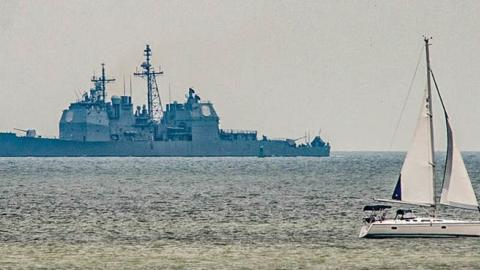U.S. Navy surface warriors meeting virtually this week are focused on improving the fleet’s training, maintenance, and leadership—worthy topics during an intensifying competition with the People’s Republic of China and a global pandemic. However, the surface fleet faces more fundamental challenges. Unless its leaders reconsider the surface force’s operational concepts, design, and posture, it could become increasingly unsustainable and unable to address the spectrum of competition presented by the PRC’s maritime forces.
Rebalancing, but not enough
Although the Fiscal Year 2021 shipbuilding plan delivered to Congress last month was unaffordable, the Navy’s fleet architecture reflected a rebalancing of the fleet toward smaller and unmanned vessels that could and should be retained in a less-expensive plan. By retiring cruisers and destroyers at their end of service lives and replacing them with smaller less-expensive combatants the surface fleet will gain proportional options to counter gray-zone and hybrid operations by the PRC’s navy, coast guard, or maritime militia as directed by the new Tri-Service Maritime Strategy.
Perhaps more importantly, a more numerous and distributed surface force will give commanders greater flexibility in managing the force. With today’s fleet consisting of only large surface combatants and undeployable littoral combat ships, the Navy is forced to send a destroyer that costs almost $80 million a year to operate and support for every mission from a regional exercise to a show of force against the PRC. A frigate, in comparison, will cost about $50 million a year.
The surface fleet’s planned rebalancing, unfortunately, does not go far enough. Even under the Navy’s heroic assumption of 30 percent higher shipbuilding budgets during portions of the 2020s and 2030s, the FY2021 shipbuilding plan only yields 17 more surface combatants compared to today’s fleet.
The Navy is constrained from more aggressive distribution of the surface force by the price tags of its new ships. The DDG-Next planned to follow today’s Arleigh Burke destroyers is expected to cost more than $2.5 billion—a 30 percent increase over its predecessor that could go higher if it is equipped with megawatt-scale lasers or hypersonic boost-glide weapons. The frigate meant to be a more affordable counterpart to today’s destroyers is estimated to cost about $1.2 billion, or only about 30 percent less than a destroyer.
Despite their costs, the Constellation frigate and DDG-Next are likely what the Navy needs. By incorporating an Aegis Combat System, vertical-launch missiles, and sophisticated anti-submarine warfare suite, the planned frigates deliver almost all the capability of a destroyer, allowing them to replace large multimission combatants in many situations. And as Bryan McGrath argues, a DDG-Next with long-range missiles and directed-energy defenses may be right solution to complement submarines in highly-contested waters around China during the early stages of a conflict.
The question, then, is how many of each ship can and should the Navy buy? The Navy could build one DDG-Next and one frigate for the price of the two destroyers it currently buys each year. Shipbuilding budgets that match inflation could fund one or two additional frigates, which would sustain the Navy’s number of multimission combatants, but not grow or further distribute the surface fleet.
Moving on from LCS
The other roadblock to rebalancing the surface force is the Littoral Combat Ship program, now reaching its goal of 35 ships delivered or under construction. The LCS should be able to complement the surface fleet’s destroyers and frigates by providing a smaller, less multi-mission platform that can address PRC maritime aggression below the level of war as the USS Gabrielle Giffords and USS Montgomery did late last year.
Unfortunately, each LCS costs about $50 million a year per ship to operate and support—as much as the Constellationfrigate—and is hampered by design flaws, delayed mission package delivery, and manning challenges. As a result, the Chief of Naval Operations mainly intends to deploy LCS for the time being to theaters where its limitations will be less problematic, such as the Caribbean or Middle East; a poor use for ships costing almost half a billion dollars.
The surface force needs to regain the fleet distribution LCS promised but failed to deliver during its 15 years of service. The Navy intends to retire the first four ships of the class but should expand this effort to include all the hulls with significant design or material problems, which could be up to half the class. The remaining LCS should be forward-based or stationed in Japan, Bahrain, and Singapore per the Navy’s current plan, with the remainder consigned to homeland security missions around the Continental United States.
To fill the need for smaller combatants LCS is too expensive or unreliable to meet, the surface navy should accelerate development of the Future Small Surface Combatant intended to replace LCS. To mitigate the impact of bringing its costs forward, the FSSC could be merged with the current large unmanned surface vessel program to create a missile-equipped small combatant.
Merging the FSSC and LUSV programs would solve multiple problems. Being a manned vessel, the FSSC could conduct day-to-day operations like maritime security and be at sea when needed for missile strikes; the LUSV would either have to encumber surface actions groups it deploys with or get underway when needed—and potentially alert the enemy. The FSSC’s small crew would be able to fix minor mechanical failures that could prevent the LUSV from operating for more than a few weeks at a time. And the FSSC program could learn from LCS to field a reliable, focused-mission ship that is inexpensive to own and operate.
The Navy’s surface leadership will need to make hard choices like slowing DDG production, revising the LUSV program, and accelerating LCS’ replacement to achieve the rebalanced fleet it needs. Otherwise, the Navy risks a fleet it cannot afford to operate and is unable to implement the new maritime strategy’s focus on competition and deterring escalation by aggressors like the PRC.
Read in Forbes

















